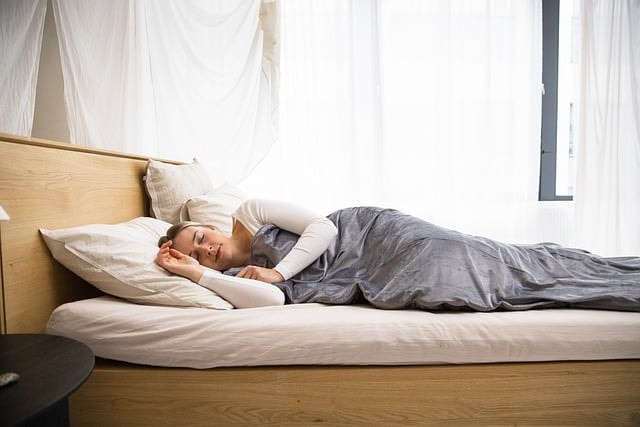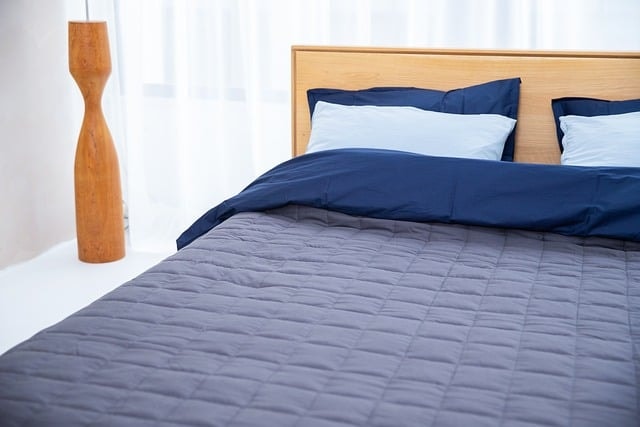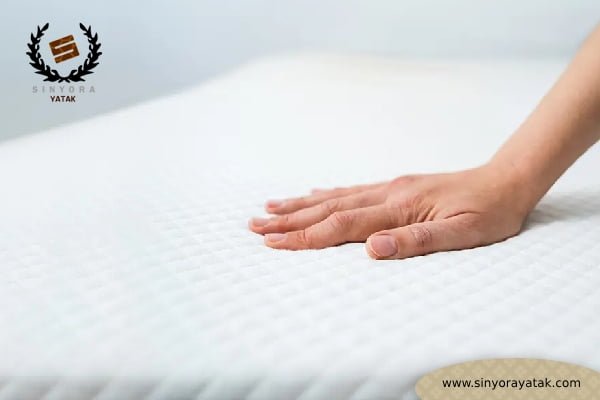Choosing the right mattress is essential for achieving a good night’s sleep and maintaining overall health.
With so many different types of mattresses on the market, it can be challenging to determine which is best for your needs.
Whether you’re dealing with back pain, are a side sleeper, or tend to sleep hot, understanding the benefits and drawbacks of each mattress type can help you make an informed decision.
This comprehensive guide will explore the most popular mattress types, their materials, and how they cater to different sleeping positions and body types.
Table of Contents
Understanding the Importance of a Good Mattress
A good mattress plays a crucial role in sleep quality and overall well-being.
The right mattress can support spinal alignment, reduce pressure points, and minimize discomfort. Conversely, a poor-quality mattress can lead to back pain, joint pain, and interrupted sleep.
The Impact of Mattress on Sleep Quality
Sleep quality is directly linked to the type of mattress you use.
A supportive mattress ensures proper spinal alignment, vital for preventing back pain and promoting deep, restorative sleep.
The right mattress should also accommodate your preferred sleeping position, whether you sleep on your back, side, or stomach.
Factors to Consider When Choosing a Mattress
When selecting a mattress, several factors should be considered, including:
Sleeping Position: Different mattresses provide varying levels of support depending on whether you’re a side sleeper, back sleeper, or stomach sleeper.
Body Weight: Your weight affects how a mattress conforms to your body and the level of support it provides.
Firmness Preference: Mattress firmness is subjective and can range from soft to firm. It’s essential to choose a firmness level that feels comfortable and supportive.
Motion Isolation: For couples, a mattress with sound motion isolation can prevent disturbances caused by a partner’s movements during the night.
Temperature Regulation: If you tend to sleep hot, choosing a mattress with cooling properties is crucial for a comfortable sleep.
Mattress Materials: The materials used in a mattress significantly impact its durability and performance. Understanding different mattress materials can help you choose one that offers the best support for your sleep position and has features like cooling capabilities.

Memory Foam Mattresses
Memory foam mattresses are among the most popular options because they can conform to the body’s shape and provide excellent pressure relief.
The foam layers in these mattresses contribute to their ability to contour to the body, offering support for areas like the hips and shoulders and enhancing overall comfort while reducing aches during sleep.
What is Memory Foam?
Memory foam is a polyurethane foam initially developed by NASA for aircraft seat cushions. It is known for its viscoelastic properties, meaning it responds to body heat and pressure by molding to the sleeper’s body.
Memory foam mattresses provide a unique feel that offers both comfort and support.
Benefits of Memory Foam Mattresses
Pressure Relief: Memory foam mattresses relieve pressure points, particularly for side sleepers. The foam conforms to the body’s contours, reducing stress on the shoulders and hips.
Spinal Alignment: Memory foam mattresses promote proper spinal alignment by contouring to the body’s shape, which can help alleviate back pain.
Motion Isolation: Memory foam is known for its excellent motion isolation properties. This feature benefits couples by minimizing disturbances caused by a partner’s movements during the night.
Suitability for Various Sleep Positions: Memory foam mattresses are versatile and accommodate different sleeping positions, including back, side, and stomach sleepers.

Drawbacks of Memory Foam Mattresses
Heat Retention: Traditional memory foam tends to retain body heat, making it less suitable for hot sleepers. However, some modern memory foam mattresses incorporate cooling gel or other technologies to mitigate this issue.
Initial Odor: When first unpacked, new memory foam mattresses may emit a chemical smell known as off-gassing. This odor usually dissipates within a few days.
Limited Edge Support: Memory foam mattresses often lack strong edge support, which can be a concern for those sitting or sleeping near the bed’s edge.
Ideal for:
Side Sleepers: Memory foam mattresses provide excellent pressure relief for side sleepers.
Couples: The motion isolation properties make memory foam an excellent choice for couples who share a bed.
Those with Back Pain: The conforming nature of memory foam helps support the spine and reduce back pain.

Innerspring Mattresses
Innerspring mattresses are one of the oldest and most traditional mattresses, known for their support and bounce.
What is an Innerspring Mattress?
An innerspring mattress features a core of steel coils or springs that provide support. The coils are typically topped with foam or fiber layers for added comfort.
The quality and durability of an innerspring mattress depend on the type of coils used and the thickness of the comfort layers.
Benefits of Innerspring Mattresses
Firm Support: Innerspring mattresses offer firm support, making them ideal for those who prefer a more traditional, bouncy feel.
Breathability: The coil structure allows for better airflow, making innerspring mattresses more breathable and more relaxed, which is beneficial for hot sleepers.
Affordability: Innerspring mattresses are generally more affordable than memory foam or latex mattresses, making them a budget-friendly option.
Wide Availability: Innerspring mattresses are widely available in various price ranges and firmness levels, providing plenty of options for consumers.
Drawbacks of Innerspring Mattresses
Pressure Points: Innerspring mattresses may create pressure points, especially for side sleepers, as the coils can press against the body.
Motion Transfer: Innerspring mattresses may not isolate motion or memory foam, which can be a drawback for couples.
Durability: The coils in innerspring mattresses can wear out over time, leading to sagging and reduced support.
Ideal for:
Back and Stomach Sleepers: The firm support of innerspring mattresses is ideal for back and stomach sleepers.
Hot Sleepers: The breathability of innerspring mattresses suits those who sleep hot.
Budget-Conscious Buyers: Innerspring mattresses are often more affordable, making them a good choice for budget-conscious consumers.
Latex Mattresses
Latex mattresses are known for their durability, responsiveness, and natural materials.
What is a Latex Mattress?
Latex mattresses are made from natural or synthetic latex, a material derived from the sap of rubber trees.
Natural latex mattresses are prized for their eco-friendliness and hypoallergenic properties. Latex mattresses can be either all-latex or a combination of latex and other materials, such as foam.
Benefits of Latex Mattresses
Durability: Latex mattresses are highly durable and can last significantly longer than other mattress types, making them a worthwhile investment.
Responsiveness: Latex provides a responsive sleep surface that quickly adjusts to your movements, offering a balance of support and comfort.
Eco-Friendly: Natural latex mattresses are made from sustainable and biodegradable materials, making them an environmentally friendly option.
Temperature Regulation: Latex mattresses have good breathability, which helps regulate body temperature and prevents overheating.
Hypoallergenic: Latex is naturally resistant to dust mites, mold, and mildew, making it a good choice for allergy sufferers.
Drawbacks of Latex Mattresses
Cost: Latex mattresses, especially those made from natural latex, can be more expensive than other mattresses.
Weight: Latex mattresses are heavier and more challenging to move, which can be a consideration during mattress removal or relocation.
Firmness: Latex mattresses are firmer, which may be better for those who prefer a softer sleep surface.
Ideal for:
Back Sleepers: Latex mattresses provide the firm support needed for proper spinal alignment in back sleepers.
Eco-Conscious Consumers: Natural latex mattresses are an excellent choice for eco-friendly, sustainable mattresses.
Allergy Sufferers: The hypoallergenic properties of latex make it a great option for people with allergies.
Hybrid Mattresses
Hybrid mattresses combine the features of different mattress types to offer a balanced sleep experience.
What is a Hybrid Mattress?
A hybrid mattress typically combines an innerspring support core with layers of memory foam, latex, or other materials. This combination offers the best of both worlds: the support of an innerspring mattress and the comfort of foam or latex.
Benefits of Hybrid Mattresses
Balanced Support and Comfort: Hybrid mattresses blend support and comfort, making them suitable for many sleepers.
Pressure Relief: A hybrid mattress’s foam or latex layers offer pressure relief, while the innerspring core provides support.
Temperature Regulation: Hybrid mattresses often feature breathable materials and cooling technologies to help regulate body temperature.
Motion Isolation: Many hybrid mattresses incorporate individually wrapped coils, which help reduce motion transfer and provide good motion isolation.
Drawbacks of Hybrid Mattresses
Cost: Due to their complex construction, hybrid mattresses can be more expensive than traditional innerspring or memory foam mattresses.
Weight: Hybrid mattresses are heavier, making moving or mattress removal more challenging.
Inconsistent Quality: The quality of hybrid mattresses can vary depending on the materials used and the construction, so choosing a reputable brand is essential.
Ideal for:
Combination Sleepers: Hybrid mattresses are ideal for combination sleepers who change positions throughout the night, as they offer a balance of support and comfort.
Couples: The motion isolation provided by individually wrapped coils makes hybrid mattresses a good choice for couples.
Hot Sleepers: The temperature-regulating properties of hybrid mattresses make them suitable for hot sleepers.
Firmness and Sleeping Positions
Choosing the right mattress firmness is crucial for ensuring comfort and support based on your preferred sleeping position.
Firmness Scale
A mattress’s firmness is typically rated on a scale from 1 to 10, with 1 being the softest and ten being the firmest.
Most mattresses fall within the medium-firm range (5-7), which offers a balance of comfort and support for most sleepers.
Best Firmness for Different Sleeping Positions
Side Sleepers: Side sleepers need a mattress that relieves pressure for the shoulders and hips. A medium-soft to medium-firm mattress (3-6 on the firmness scale) is ideal for this sleep position, as it conforms to the body’s curves while offering support.
Back Sleepers: Back sleepers require a mattress that supports the spine’s natural curve. A medium-firm to firm mattress (5-7 on the firmness scale) is recommended for this sleep position, as it provides the necessary support without causing discomfort.
Stomach Sleepers: Stomach sleepers need a firm mattress (6-8 on the firmness scale) to prevent the hips from sinking too far into the bed, which can lead to spinal misalignment and back pain.
Combination Sleepers: Combination sleepers who change positions throughout the night should opt for a medium-firm mattress (5-7 on the firmness scale) that offers a balance of support and comfort for all sleep positions.
Specialty Mattresses and Mattress Toppers
In addition to the standard mattress types, specialty mattresses, and mattress toppers offer additional comfort and support for specific needs.
Mattress Toppers
A mattress topper is an additional layer of cushioning that sits on top of your mattress to enhance comfort and adjust the firmness level. Toppers are available in various materials, including memory foam, latex, and down.
Benefits of Mattress Toppers
Enhanced Comfort: A mattress topper can add an extra layer of comfort, making a firm mattress feel softer or providing additional support to a soft mattress.
Pressure Relief: Memory foam and latex toppers offer additional pressure relief, benefiting side sleepers and those with joint pain.
Temperature Regulation: Cooling gel-infused memory foam toppers can help regulate body temperature, making them ideal for hot sleepers.
Drawbacks of Mattress Toppers
Limited Impact: While toppers can improve comfort, they cannot fix an old or sagging mattress. If your mattress is no longer supportive, it may be time for a new mattress purchase.
Motion Transfer: Toppers may not provide the same level of motion isolation as a full mattress, so couples may still experience disturbances from a partner’s movements.
Specialty Mattresses
Specialty mattresses, such as those designed for adjustable bed frames or those with advanced cooling technologies, cater to specific needs and preferences.
Adjustable Mattresses
Adjustable mattresses are compatible with adjustable bed frames, allowing you to change the position of the mattress for customized comfort. These mattresses are ideal for people with medical conditions that require elevation or those who enjoy reading or watching TV in bed.
Cooling Mattresses
Cooling mattresses are designed to regulate body temperature and prevent overheating during the night. These mattresses often incorporate breathable materials, cooling gel, or advanced airflow technologies.
Benefits of Specialty Mattresses
Customized Comfort: Specialty mattresses offer tailored comfort and support based on your needs and preferences.
Advanced Technologies: Many specialty mattresses feature the latest innovations in sleep technology, such as cooling properties, adjustable firmness, and enhanced support.
Drawbacks of Specialty Mattresses
Cost: Specialty mattresses are more expensive due to their advanced features and technologies.
Limited Availability: Specialty mattresses may not be as widely available as standard mattress types, making it more challenging to find the right option.
Mattress Care and Maintenance
Proper care and maintenance can extend the life of your mattress and ensure that it continues to provide comfort and support.
Mattress Removal and Replacement
Proper mattress removal is essential when purchasing a new mattress. Many mattress companies offer old mattress removal services when delivering a new mattress.
It’s important to responsibly dispose of your old mattress, as improper disposal can contribute to environmental waste.
Mattress Care Tips
Regular Cleaning: Vacuum your mattress regularly to remove dust, dirt, and allergens. Use a mattress cover to protect against spills and stains.
Rotation: Rotate your mattress every few months to prevent uneven wear and sagging. This is especially important for innerspring and hybrid mattresses.
Supportive Bed Frame: Ensure your mattress is placed on a supportive foundation. Using the wrong bed frame can damage the mattress and void the warranty.
Mattress Topper: Adding a mattress topper can protect the surface of your mattress and provide additional comfort.
Choosing the Right Mattress for You
Selecting the right mattress involves considering your needs, preferences, and budget. Here’s a quick summary to help you choose the best mattress:
Memory Foam Mattresses are ideal for side sleepers, those with back pain, and couples who need sound motion isolation.
Innerspring Mattresses are best for back and stomach sleepers who prefer a firm, bouncy feel and hot sleepers who need breathability.
Latex Mattresses: Suitable for back sleepers, eco-conscious consumers, and allergy sufferers looking for durability and responsiveness.
Hybrid Mattresses: Perfect for combination sleepers, couples, and hot sleepers who want a balance of support and comfort.
Final Thoughts on Mattress Selection
Investing in a quality mattress is crucial for your health and well-being. Take the time to research different mattress types, consider your sleep needs, and test out mattresses in-store.
With the right mattress, you can enjoy a comfortable and restful night’s sleep, free from back pain and discomfort.
Contact us today and get the best offer!
1. Which type of mattress is best for back pain?
Memory foam and latex mattresses are often recommended for individuals with back pain because they provide excellent support and conform to the body’s shape, promoting proper spinal alignment. Medium-firm mattresses are generally best for supporting the back while still offering comfort.
2. What is the difference between memory foam and latex mattresses?
Memory foam mattresses are known for their contouring properties, which allow them to conform closely to the body’s shape, offering pressure relief. Latex mattresses, on the other hand, are more responsive and bouncy, providing a firmer feel and better airflow, which helps with temperature regulation. Latex is also a more durable and eco-friendly material than memory foam.
3. Are hybrid mattresses better than innerspring mattresses?
Hybrid mattresses combine the support of innerspring coils with the comfort of foam or latex layers, offering a balanced sleep experience. They typically provide better pressure relief and motion isolation than traditional innerspring mattresses. However, the best choice depends on individual preferences and sleep needs.
4. What firmness level should I choose for my mattress?
The firmness level you choose should be based on your sleeping position and personal comfort preferences:
Side sleepers generally prefer a medium-soft to medium-firm mattress (3-6 on the firmness scale) to relieve pressure on the shoulders and hips.
Back sleepers should opt for a medium-firm to firm mattress (5-7 on the firmness scale) to support the spine’s natural curve.
Stomach sleepers typically need a firmer mattress (6-8 on the firmness scale) to prevent the hips from sinking too far and causing back strain.
5. How often should I replace my mattress?
On average, a mattress should be replaced every 7-10 years, depending on the type and quality of the mattress. Signs that you need a new mattress include sagging, lumps, and discomfort during sleep. Memory foam and latex mattresses tend to last longer than innerspring mattresses.
6. Do I need a mattress topper if I have a new mattress?
A mattress topper can enhance the comfort of a new mattress, especially if you find the mattress too firm or too soft. Toppers can also provide additional pressure relief and cooling benefits. However, a topper may not be necessary if your new mattress is already comfortable and supportive.
7. What is the best mattress for hot sleepers?
Hot sleepers should consider mattresses with cooling properties, such as latex mattresses, hybrid mattresses with cooling gel layers, or memory foam mattresses with advanced airflow technologies. These mattresses help regulate body temperature and prevent overheating during the night.
8. Are there any specific mattresses for people with allergies?
Latex mattresses, especially those made from natural latex, are hypoallergenic and resistant to dust mites, mold, and mildew, making them an excellent choice for people with allergies. Memory foam mattresses with hypoallergenic covers can also be a good option.
9. What should I consider when buying a mattress for a couple?
Couples should look for a mattress that provides good motion isolation to minimize disturbances from a partner’s movements. Memory foam and hybrid mattresses with individually wrapped coils are known for their motion isolation properties. A mattress with a balanced firmness level that suits both partners is essential for shared comfort.
10. How can I keep my mattress in good condition?
To extend the life of your mattress, rotate it every few months to prevent uneven wear, vacuum it regularly, and use a mattress cover to protect it from spills and stains. Ensure your mattress is placed on a supportive bed frame or foundation, and consider using a mattress topper for added protection and comfort.
Read also:
Best Mattress Options for Different Budgets: A Guide from Sinyora



